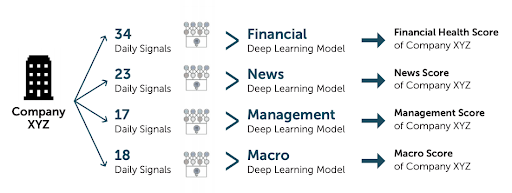Renaissance Technologies, a hedge fund founded by the mathematician and Cold War codebreaker James Simon, famously averaged a 71.8% annual return, before fees, between 1994 and 2014. Using statistics and an army of mathematicians and physicists, the hedge fund’s runaway success cemented the role of data science in finance.
Let’s look at how artificial intelligence could accelerate these trends following the rise of deep learning in the 2010s—along with some retail ETFs incorporating the technology.
See our Active ETFs Channel to learn more about this investment vehicle and its suitability for your portfolio.
How AI Plays a Role in Finance
Artificial intelligence has been around for decades, but it experienced a significant leap in capabilities with the rise of deep learning. In 2016, Google’s DeepMind defeated South Korean Go champion Se-dol four to one, demonstrating that cutting-edge AI could play even the most complex games that humanity had to offer.
These same capabilities could revolutionize the financial industry. While statistics show patterns in data, machine learning goes a step further, identifying patterns that humans overlook. Algorithms develop these intuitions by ‘training’ with volumes of historical data with little more than a goal to optimize for (e.g., profitability in the case of investment).
The downside is that an AI’s knowledgebase is a black box. Since they teach themselves, they may take approaches that humans don’t understand. For example, image recognition systems may accurately identify people or driving lanes, but they’re wildly inaccurate when there’s a seemingly subtle (to a human) visual difference.
The Rise of AI-Powered ETFs
Artificial intelligence and machine learning may be prevalent among quant hedge funds, but the tech revolution is just starting to reach retail investors via exchange-traded funds (ETFs). While smart beta ETFs offer some of these capabilities, AI-powered ETFs may open the door to new opportunities and potentially new risks to keep in mind.
AI-Powered Equity ETF (AIEQ)
ETFmg’s AI-Powered Equity ETF (AIEQ) is an actively-managed fund utilizing IBM Watson (IBM’s artificial intelligence) to analyze millions of data points and select stocks. In particular, the AI looks at news, social media, analyst opinions, and financial statements along with technical, macro, and market data covering over 6,000 U.S. companies.

Let Bob AI Momentum ETF (LETB)
Software engineer Anthony Buchanan founded Let Bob LLC in 2017 to combine fundamental and technical analysis with a systematic process that removes emotion from investment decisions. And in early 2022, AdvisorShares partnered to launch the actively-managed AdvisorShares Let Bob AI Momentum ETF (LETB).
LETB starts with a universe of 3,000 U.S. small-, mid-, and large-cap stocks and then uses machine learning and alternative data analytics to identify companies growing faster than Wall Street expectations. Then, the fund’s proprietary technical analysis determines when to add the stocks and how long to hold them to maximize profitability.
QRAFT AI ETFs
QRAFT AI ETFs is an issuer that has a family of four AI-enhanced ETFs targeting large-cap, large-cap momentum, high-dividend, and value opportunities. These funds leverage AI to continuously discover the correlation between valuation, volatility, or momentum factors and various macroeconomic and valuation conditions.
| Ticker | Name | Expense Ratio | YTD Return |
|---|---|---|---|
| QRFT | AI-Enhanced U.S. Large-Cap ETF | 0.75% | -10.14% |
| AMOM | AI-Enhanced U.S. Large-Cap Momentum ETF | 0.75% | -18.22% |
| HDIV | AI-Enhanced U.S. High Dividend ETF | 0.75% | -2.28% |
| NVQ | AI-Enhanced U.S. Next Value ETF | 0.75% | 1.73% |
Don’t forget to explore our Dividend Guide where you can access all the relevant content and tools available on Dividend.com based on your unique requirements.
Risks to Keep in Mind
Artificial intelligence will play a key role in security selection and portfolio management in the future. However, there are some critical risk factors to consider when evaluating these opportunities.
The three most prominent risks include:
- Black Box Strategies – Many artificial intelligence algorithms are black boxes by nature, meaning there’s little specific insight into how they arrive at investment decisions. As a result, the strategies may be vulnerable to black swan events or even be fraudulent, since it may not be possible to verify or assess the AI.
- Limited Track Record – Many funds incorporating artificial intelligence are early-stage, meaning they have a more limited track record than quant funds. As a result, investors may want to take recent performance with a grain of salt since the funds haven’t been through multiple market cycles.
- High Expenses – Some funds may have higher expense ratios than passively-managed index funds. As a result, investors must weigh the benefits of AI against the impact of these higher costs on long-term returns. In addition, these funds may engage in more trading, resulting in potential tax implications (e.g., mutual funds).
The Bottom Line
Artificial intelligence and machine learning have rapidly evolved over the past few years with the advent of deep learning. With many AI-powered or AI-enhanced ETFs coming onto the market, these technologies are becoming available to retail traders. However, there are several risk factors to remember before committing any capital.
Take a look at our recently launched Model Portfolios to see how you can rebalance your portfolio.





